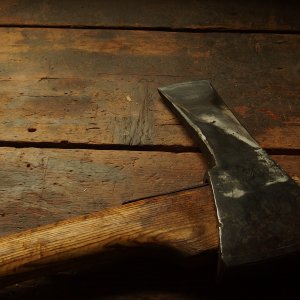Square_peg
Gold Member
- Joined
- Feb 1, 2012
- Messages
- 13,793
I've recently acquired an old mortising axe out of Pennsylvania. I've had my eyes open for one of these as I'm considering building a split-rail fence the old fashioned way. This is just what I was looking for, an axe that was purpose built as a mortising axe rather than converted out of some other type of axe.

It's very poorly hung. Someone just shoved a chunk of old axe handle in it and drove in a single small metal wedge.

It has a long heavy poll to give it some weight and power. A forge weld is visible where the additional mass of the poll was added after construction of the eye, much as we saw Jake Pogg do in his 18th c. R&D thread.

I had a dickens of a time convincing my camera to focus on the top of the eye rather than whatever was in the background behind it but eventually got a decent photo. The front of the eye is clearly forge welded and doesn't appear to have a dissimilar metal between the 2 sides. It's unclear how the bit was done.

A little background on how these were used and why they are sometimes called a post axe comes from Henry Mercer's wonderful book "Ancient Carpenters' Tools". It seems one of the common tasks these axes were called on to perform was the mortising of fence posts for split rail fences.

Have a look at that massive stone wall in the background! Reminds me of Robert Frosts 'Mending Wall'. ‘Good fences make good neighbors.’
Mercer has some good examples of this axe in his book. One of his looks an awful lot like an ice axe to me. He may not have known the difference and simply reported what he was told.

He goes on to describe the use of the tool.

I hope I get a chance to put this one back to work.

It's very poorly hung. Someone just shoved a chunk of old axe handle in it and drove in a single small metal wedge.

It has a long heavy poll to give it some weight and power. A forge weld is visible where the additional mass of the poll was added after construction of the eye, much as we saw Jake Pogg do in his 18th c. R&D thread.

I had a dickens of a time convincing my camera to focus on the top of the eye rather than whatever was in the background behind it but eventually got a decent photo. The front of the eye is clearly forge welded and doesn't appear to have a dissimilar metal between the 2 sides. It's unclear how the bit was done.

A little background on how these were used and why they are sometimes called a post axe comes from Henry Mercer's wonderful book "Ancient Carpenters' Tools". It seems one of the common tasks these axes were called on to perform was the mortising of fence posts for split rail fences.

Have a look at that massive stone wall in the background! Reminds me of Robert Frosts 'Mending Wall'. ‘Good fences make good neighbors.’
Mercer has some good examples of this axe in his book. One of his looks an awful lot like an ice axe to me. He may not have known the difference and simply reported what he was told.

He goes on to describe the use of the tool.

I hope I get a chance to put this one back to work.

